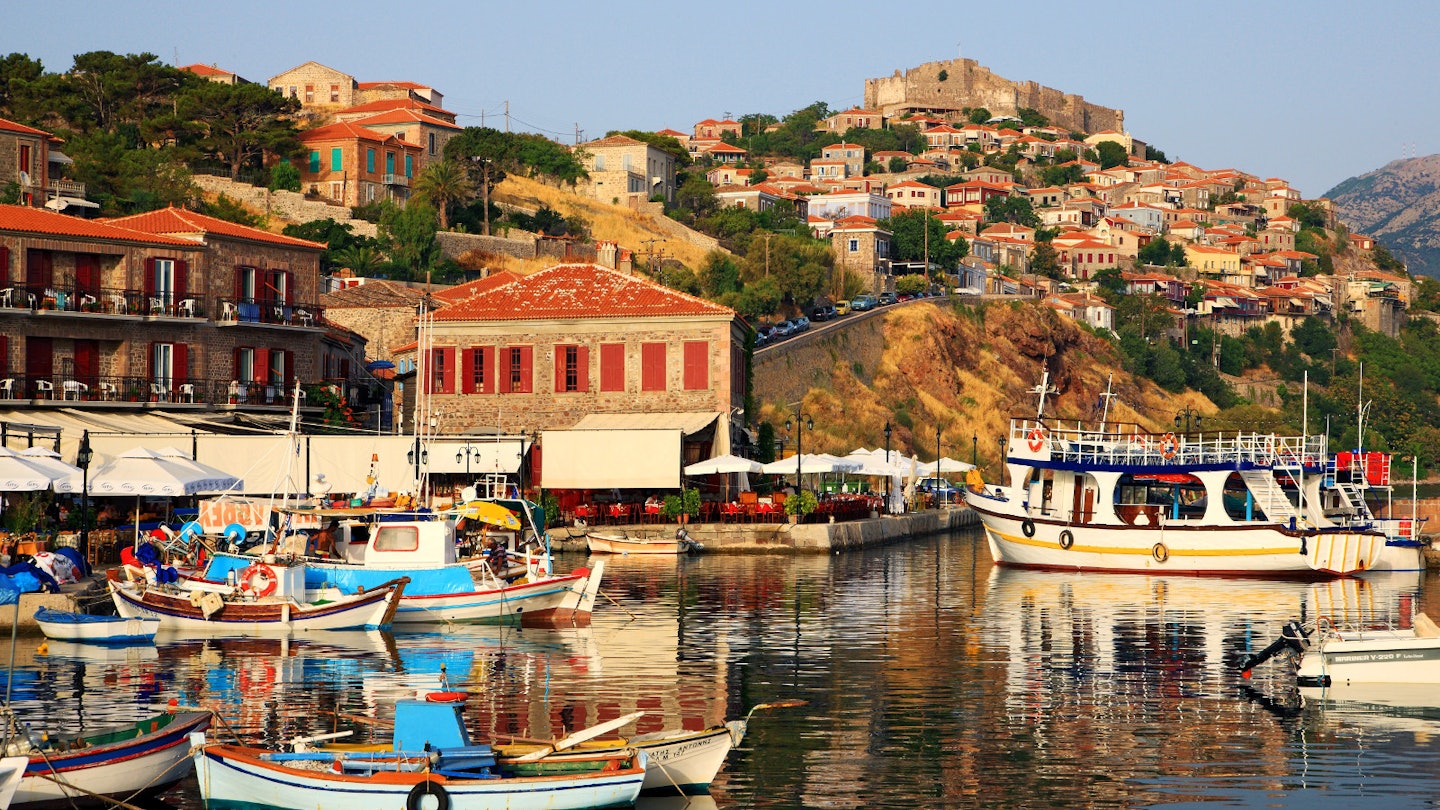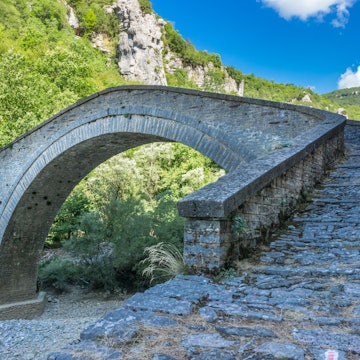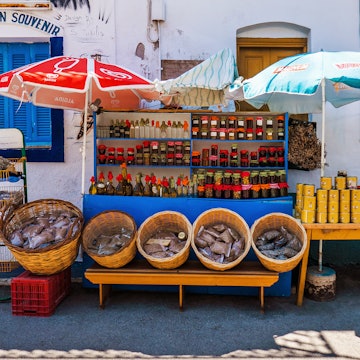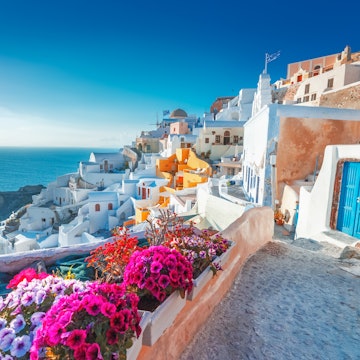

The picturesque castle-topped harbour of Molyvos (Mithymna) on Lesvos island. Heracles Kritikos / Shutterstock
Canada has Newfoundland, Russia has Kamchatka and Greek islands have their own ultimate getaway from the archipelago as we know it, incidentally also in the northeastern corner of the country. The contrast is certainly more subtle, yet one gets a distinct sense of otherness and remoteness at the first sight of wild lava-shaped terrain in southern Lesvos or the dark stone of fortified villages in Chios – a scene that can’t differ more from the dazzling-white and deep-blue colour scheme of the Cyclades.
That said, the Northeastern Aegean is hardly a backwater; rather, this is a cultural and political frontier, where Christians and Muslims have been rubbing shoulders for centuries, intermarrying and trading with each other (at least when they were not engaged in devastating wars). You can see from the Turkish signs and restaurant menus that this cultural exchange is now being revived after decades of hostility.
Located at the southeastern edge of the European Union and separated from Turkey by narrow straits, the islands were also the first to be hit by the recent wave of refugees and migrants from Asia and Africa. This is definitely not a reason for travellers to stay away, partly since that wave has subsided significantly but also because it had never really affected travellers, except for the ones who volunteered to help the arriving fugitives – and there were many people doing so.

The islands’ history of diversity and cultural amalgamation is reflected in the townscapes, and the most impressive is that of Molyvos (aka Mithymna) – a picture-perfect Ottoman town at the northern tip of Lesvos. Walk up the cobbled streets to the castle for sweeping views of the Aegean (and, perhaps, a glimpse of Turkey), then descend to the medieval Agora market square, stopping for a taverna lunch in the shade of plane trees or for Turkish-style coffee with a view at the Blue Fox coffee shop. As the sun goes down, proceed to the marina for cocktails with the merry yachtie crowd.
Another vestige of the Ottoman era are the bathhouses built on top of thermal springs scattered around Lesvos. The Mineral Baths of Eftalou, a couple of kilometres from Molyvos, are both the oldest and most atmospheric. The punctured vaulted ceiling creates a colonnade of light shafts, with tiny clouds of vapour drifting through them like friendly ghosts – and as you lie submerged in very hot, mineral-rich water, your mind starts floating towards the dreamiest of nirvanas. Waking up from it, you can cool down in the sea and come back for another session. A modernised version of the same can be found at Therma Spa near the island’s capital, Mytilini Town. This slick facility features both an Ottoman-era spa, a bar and an elevated outdoor pool which faces the Gulf of Gera in such manner that if you place your cocktail on the edge, it will be the only thing between yourself and the horizon.
Lesvos is huge by Greek island standards, and its upturned-cauliflower shape slows down the travel between its three parts separated by swathes of water. Rent a car in Mytilini Town and drive to the farthest west of the island, where lava flows formed a lunar landscape dotted with petrified tree trunks, frozen in time a few million years before the birth of first humans.
Spend some time on the beach and in the excellent bars of the super-laidback resort town of Skala Eresou, famous as the birthplace of poet Sappho and therefore a magnet for lesbian travellers. Then drive back slowly, stopping at mountain villages for a cup of Greek coffee with ‘sweet spoons’, which stands for caramelised fruit and vegetables – from fig and grape to aubergine and tomato.
The island of Chios has an even more singular character than Lesvos and feels like a country inside a country. Orange growers may sound like the sweetest people on Earth, but their fortress-like houses turn Kampos, a vast suburban area outside Chios Town, into a barely navigable stonewall maze with domestic life hidden from prying eyes – a tradition that harks back to the times of mutual distrust and perpetual combat-readiness. Thankfully, it’s easy to sneak in and see the rather idyllic-looking inner courtyards blending into orange orchards. Some of these stone houses are now hotels, and one is a museum – of citrus growing, naturally.

But the most outstanding architecture on Chios is left by farmers who grow mastic. Two of their villages, Mesta and Olympi, are proper fortresses with thick outside walls and a medieval maze of lanes inside them. However, the largest village, Pyrgi, puts aesthetics ahead of military expedience. Every house here is covered with intricate black-and-white geometric ornament that reminds one of either Islamic art or Kazimir Malevich’s suprematism.
Several of these buildings, such as Mastiha House, have rooms for rent, so you can experience a majestic but rather traditional place where social life alternates between church services and long evenings out at a kafeneio (coffee house) – still largely a male-only pastime (though it’s not that women are unwelcome). Despite its non-touristy character, the village claims to be the birthplace of Columbus; many locals carry the same surname and there’s even a house which everyone here will insist to be the exact place of the discoverer’s birth. Columbus was, of course, documented as Genovese, but the locals maintain that Chios was part of the Genovese Republic at the time, so this isn’t necessarily a contradiction.
Chios was the only place in the known world where mastic growing was commercially viable, so the arduous labour of collecting mastic tree sap, drop by drop, made the islanders very rich but also subject to severe reprisals from the Ottoman authorities. This tragic story is related at the new state-of-the-art Chios Mastic Museum near Pyrgi – an airy edifice perched on the hilltop and surrounded by a mastic plantation.
Beyond the museum, the main road descends to Mavra Volio, a famous beach covered in coal-black pebbles, which gives it a slight spooky but also bohemian feel. And, just like in other parts of Chios and Lesvos, you’ll really appreciate being here only after having visited the more touristy islands and beaches. The Northeastern Agean is indeed the PhD of Greek travel – if you’ve found yourself here, congratulate yourself for having developed into a real island connoisseur.














